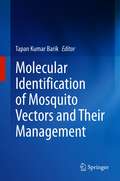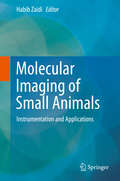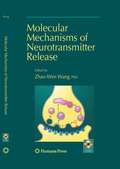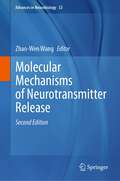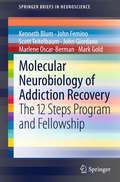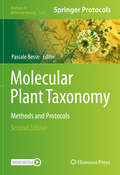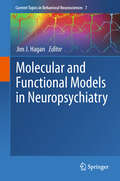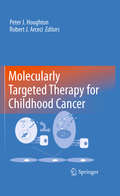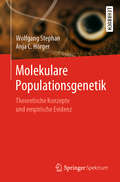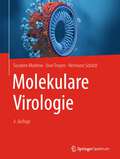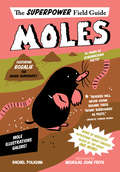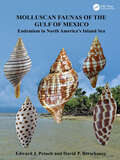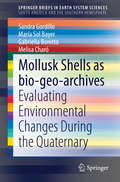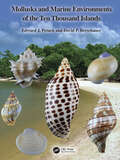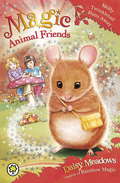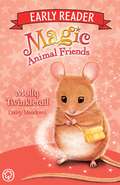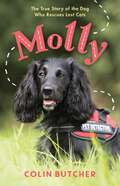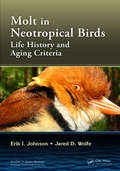- Table View
- List View
Molecular Identification of Mosquito Vectors and Their Management
by Tapan Kumar BarikThis book summarizes the recent advancements in identifying the mosquito vectors and discusses various strategies for their control. The book describes various molecular taxonomic methods, including DNA barcoding and single nucleotide polymorphism-based machine learning approach, which are used for the identification of mosquito vectors. It also presents the various mosquito control methods, namely, phytochemicals, Bacillus thuringiensis toxins, nanotechnology, biological control agents, and environmental management strategies. It also highlights the importance of various repellents that are used for protection from different kinds of mosquito vectors. Finally, the book offers a comprehensive yet representative description of challenges associated with mosquito vector-borne diseases. The book is a useful resource for medical entomologists, health workers, and researchers working in mosquito-control and vector-borne diseases.
Molecular Imaging of Small Animals
by Habib ZaidiThis book examines the fundamental concepts of multimodality small-animal molecular imaging technologies and their numerous applications in biomedical research. Driven primarily by the widespread availability of various small-animal models of human diseases replicating accurately biological and biochemical processes in vivo, this is a relatively new yet rapidly expanding field that has excellent potential to become a powerful tool in biomedical research and drug development. In addition to being a powerful clinical tool, a number of imaging modalities including but not limited to CT, MRI, SPECT and PET are also used in small laboratory animal research to visualize and track certain molecular processes associated with diseases such as cancer, heart disease and neurological disorders in living small animal models of disease. In vivo small-animal imaging is playing a pivotal role in the scientific research paradigm enabling to understand human molecular biology and pathophysiology using, for instance, genetically engineered mice with spontaneous diseases that closely mimic human diseases.
Molecular Mechanisms of Neurotransmitter Release
by Zhao-Wen WangWithin the complex neuronal network of the nervous system, neuron-to-neuron communication occurs mainly through chemical synapses, where the presynaptic nerve terminal releases neurotransmitters which control the function of postsynaptic neurons by acting on postsynaptic receptors. Recent decades have brought ground-breaking new developments and a wealth of knowledge to this field. In 'Molecular Mechanisms of Neurotransmitter Release', leading experts provide concise, up-to-date information on all major molecular mechanisms involved, with complete background information and figures and diagrams to further elucidate key concepts or experiments. Comprehensive and cutting-edge, 'Molecular Mechanisms of Neurotransmitter Release' is sure to provide a learning tool for neuroscience students, a solid reference for neuroscientists, and a source of knowledge for all those who have a general interest in the ever-evolving field of neuroscience
Molecular Mechanisms of Neurotransmitter Release (Advances in Neurobiology #33)
by Zhao-Wen WangNeurons communicate with each other by releasing neurotransmitters. This book provides comprehensive coverage of the molecular mechanisms involved in neurotransmitter release. The topics covered in the book range from the architecture and cytomatrix proteins of presynaptic sites, to the modes of synaptic vesicle exocytosis (full-collapse and kiss-and-run), and from the key molecules mediating synaptic vesicle fusion (SNAREs) to those that closely interact with them (UNC-13/Munc13, UNC-18/Munc18, tomosyn, and complexins). The book also delves into the calcium sensors of synaptic vesicle fusion (synaptotagmins and Doc2s), the sources of calcium that trigger synaptic exocytosis (voltage-gated calcium channels and ryanodine receptors), and the regulation of neurotransmitter release by potassium channels, cell adhesion molecules, lipids, aryl hydrocarbon receptor-interacting protein (AIP), presenilins, and calstabins. To aid in understanding and illustrate key concepts, the book includes sufficient background information and a wealth of illustrations and diagrams. The new edition includes major updates to previous chapters, as well as several new chapters that reflect the recent advances in the field. Comprehensive and cutting-edge, Molecular Mechanisms of Neurotransmitter Release, 2nd edition, is a valuable learning resource for neuroscience students and a solid reference for neuroscientists.
Molecular Neurobiology of Addiction Recovery
by Kenneth Blum Marlene Oscar-Berman John Femino John Giordano Mark Gold Scott TeitelbaumHumans are biologically programmed to seek out pleasurable experiences. These experiences are processed in the mesolimbic system, also referred to as the "reward center" of the brain, where a number of chemical messengers work in concert to provide a net release of dopamine in the Nucleus Accumbens. In some genetically predisposed individuals, addiction occurs when the mechanisms of the mesolimbic system are disrupted by the use of various drugs of abuse. Since Alcoholics Anonymous was founded in 1935, it's 12 step program of spiritual and character development has helped countless alcoholics and drug addicts curb their self-destructive behaviors. However, the program was developed at a time when comparatively little was known about the function of the brain and it has never been studied scientifically. This is the first book to take a systematic look at the molecular neurobiology associated with each of the 12 steps and to review the significant body of addiction research literature that is pertinent to the program.
Molecular Physiology and Evolution of Insect Digestive Systems (Entomology in Focus #7)
by Walter R. Terra Clelia Ferreira Carlos P. SilvaThis book provides a unique blend of data on insect life spans, physiology, enzymology and other molecular features associated with digestion and nutrient absorption to enrich the knowledge on insects and to disclose putative molecular targets for the development of new insect control technologies and for improving insect raising procedures to be used as food and feed. With this aim, the book overviews the types of diets consumed by insects, describing their chemical components demanding digestion and discusses the evolutionary selective pressures on insects associated with feeding. Digestive enzymes are classified and detailed according to their activity on substrates and their evolutionary protein families. The technical details on how to obtain reliable enzymological parameters are discussed. The book reviews the structural changes in enzymes associated with the adaptation of insects to new diets and in avoiding natural plant inhibitors. Midgut features that enhance digestive and nutrient absorption efficiency and their underlying molecular mechanisms are described regarding insects pertaining to key points in evolution. Evolutionary trends of the mechanisms of digestion and nutrient absorption are discussed.
Molecular Plant Taxonomy: Methods and Protocols (Methods in Molecular Biology #2222)
by Pascale BesseThis fully updated edition explores conceptual as well as technical guidelines for plant taxonomists and geneticists, such as the increasing use of next-generation sequencing (NGS) technologies for numerous applications in plant taxonomy. The volume provides molecular approaches to be used within an “integrative taxonomy” framework, combining a range of nucleic acid and cytogenetic data together with other crucial information (taxonomy, morphology, anatomy, ecology, reproductive biology, biogeography, paleobotany, etc.), which will help not only to best circumvent species delimitation but also to resolve the evolutionary processes in play. Written for the highly successful Methods in Molecular Biology series, chapters include introductions to their respective topics, lists of the necessary materials and reagents, step-by-step, readily reproducible laboratory protocols, and tips on troubleshooting and avoiding known pitfalls. Authoritative and up-to-date, Molecular Plant Taxonomy: Methods and Protocols, Second Edition is an ideal guide for researchers seeking a better understanding of evolutionary processes, at species and population level, through molecular techniques.
Molecular Toxicology in Caenorhabditis elegans
by Dayong WangThis book will focus on the molecular basis of oxidative stress induced by toxicants or stresses and various molecular signalling pathways in regulating the toxicity of toxicants or stresses in Caenorhabditis elegans. It will also cover the discussion on the aspects of response signals, G-protein coupled receptors and ion channels, specific molecular signals, and epigenetic signals involved in the regulation of toxicity from toxicants or stresses. The molecular basis for adaptive response for transgenerational toxicity of environmental toxicants or stresses will be further discussed. Nematode Caenorhabditis elegans is a classic model animal with well-described genetic and developmental backgrounds based on the study of life science, and has been further successfully and widely used in both toxicity assessment and toxicological study of various environmental toxicants or stresses. Based on related available data, this book aims at providing a systematic understanding of the knowledge system of molecular toxicology in C. elegans.
Molecular and Functional Models in Neuropsychiatry
by Jim J. HaganThe development of more effective treatments for neuropsychiatric disorders requires scientific progress on a broad front. Animal models have a vital role to play in advancing the field. When deployed in conjunction with detailed study of these diseases in man they bring the power to make controlled experimental interventions which allow the functional consequences of genetic variations and polymorphisms to be understood in terms of their cellular, systems and behavioural effects. Further, they provide a means by which complex cognitive and behavioural phenomena may be dissected and understood. Finally, they provide a bridge to understanding the effects of drugs on the functioning of the central nervous system, thereby improving our understanding of the actions of those drugs in man.
Molecularly Targeted Therapy for Childhood Cancer
by Peter J. Houghton Robert J. ArceciEach chapter will focus on the known molecular characteristics of specific childhood cancers, focusing on how the molecular 'drivers' can be exploited from a therapeutic standpoint with currently available targeted agents. Where applicable, integration of targeted therapies with conventional cytotoxic agents will be considered. This volume will provide a comprehensive summary of molecular characteristics of childhood cancers, and how the changes involved in transformation provide us with opportunities for developing relatively less toxic, but curative, therapies.
Molekulare Populationsgenetik: Theoretische Konzepte und empirische Evidenz
by Wolfgang Stephan Anja C. HörgerDas Buch behandelt die genetische Vielfalt von Populationen von Organismen. Es erläutert, wie genetische Vielfalt gemessen wird und wie aus diesen Daten die Mechanismen untersucht werden können, die die Variabilität auf der Genomebene und damit die Mikroevolution einer Population beeinflussen. Ziel dieses Buches ist es, das Wirken der natürlichen Selektion im Genom zu verstehen und vom Einfluss neutraler Evolutionskräfte (wie genetischer Drift, Mutation und Rekombination) unterscheiden zu lernen. Dazu werden die grundlegenden theoretischen Konzepte der Populationsgenetik eingeführt und anhand von zahlreichen Beispielen aus allen Organismengruppen (Menschen, Tieren, Pflanzen und Mikroorganismen) veranschaulicht. Um das Verständnis der theoretischen Ableitungen von Hypothesen und der darauf basierenden Datenanalysen zu überprüfen und weiter zu vertiefen, schließt jedes Kapitel mit Übungsaufgaben und Lösungen ab.
Molekulare Virologie
by Hermann Schätzl Susanne Modrow Uwe TruyenDieses bewährte Standardwerk vermittelt einen ausgewogenen Überblick über die bekannten humanpathogenen und tierpathogenen Viren, wie beispielsweise Papilloma- und Influenzaviren und wurde ergänzt um die eher neu aufgetretenen Viren, insbesondere Zikavirus, das neuartigen Coronavirus SARS-CoV-2 und das Schmallenberg-Virus, einem Bunyavirus, das Rinder, Schafe und Ziegen infiziert.Der erste Teil des Buches präsentiert die allgemeinen Prinzipien der Struktur, Vermehrung und Lebenszyklen von Viren und beschreibt die wichtigsten pathogenetischen und immunologischen Mechanismen viraler Erkrankungen. Auch die Diagnostik und Therapie sowie die Epidemiologie solcher Infektionen und das heutige Methodenrepertoire der Virologen werden hier vorgestellt.Der zweite, spezielle Teil führt systematisch durch die Vielfalt der human- und tierpathogenen Viren. Ausführlich dargestellt sind hier Morphologie, Genomorganisation, Proteinausstattung sowie Replikationsmechanismen der verschiedenen Virusfamilien. Für die jeweils wichtigsten Vertreter liefern die Autoren einen Überblick über die relevanten humanmedizinisch-klinischen beziehungsweise veterinärmedizinischen Aspekte. Auch seuchenrechtliche Fragen kommen hier zur Sprache.Das Lehrbuch dient seit vielen Jahren als bewährte Einführung in die molekular- und zellbiologischen Grundlagen der Virologie und ist unentbehrlich für Fachleute und Studierende. Die 4. Auflage wurde ergänzt mit den aktuellen Daten zu den jeweiligen Viren und bietet somit einen aktuellen Überblick zu den Replikationsstrategien und verbindet diese mit der Pathogenese der Erreger. Integriert wurden Virusspezies, die während der vergangenen Jahre neu aufgetreten sind und in vieler Hinsicht die öffentliche Diskussion beherrscht haben. Nicht zuletzt zählen hierzu die Infektionen des Menschen mit dem neuartigen Coronavirus SARS-CoV-2, dem Zikavirus, den tier- wie humanpathogenen Bornaviren sowie dem Schmallenberg-Virus, dessen Infektion bei Wiederkäuern schwere Fetopathien verursacht. Mit seiner klaren Gliederung und verständlichen Darstellung weist dieses systematisch angelegte Lehr- und Nachschlagewerk• Studierenden und Lehrenden in Biowissenschaften, Human- und Veterinärmedizin• Virologen, forschungsorientierten Klinikern, Tierärzten und Seuchenmedizinern sowie• Fachleuten in Mikrobiologie, Hygiene und Diagnostikden Weg durch die Vielfalt der virologischen Forschungsergebnisse.
Moles (Superpower Field Guide)
by Rachel PoliquinFunny and fact-filled, MOLES is another installment in the SUPERPOWER FIELD GUIDES series by author Rachel Poliquin, featuring full-color illustrations by Nicholas John Frith that will engage readers with witty narration and fun visual elements, inspiring readers to dig deep and see the world, both above and below ground, with new eyes. Meet Rosalie, a common mole. The first thing you need to know about Rosalie is that she is shaped like a potato. Not a new potato, all cute and round, but a plain old lumpy potato. She may be small. She may be spongy. But never underestimate a mole. I know what you’re thinking: moles are just squinty-eyed beasts that wreck your lawn. You’re right! Those squinty eyes and mounds of dirt are proof that moles have superpowers. There is absolutely nothing common about the common mole.
Molla e i saltasassi
by Rafael EstradaVi ho mai raccontato la storia di Molla? Molla era un bambino con il naso da topo, lo sguardo sognante e i capelli da porcospino. Credeva di poter fare qualunque cosa gli venisse in mente, tanto era buono ed innocente. —Mi piacerebbe saper saltare come i saltasassi —disse un giorno, quasi senza sapere perché, abbastanza forte da essere sentito da tutti. Sua madre, Balestra, sorrise come fanno le mamme; Elastico, suo padre, tossì come fanno i papà; e il nonno mosse il capo su e giù. Balestra conosceva più di chiunque altro la tendenza di Molla ad immaginare cose impossibili, e mentre gli pettinava gli indomabili capelli, con tutta la pazienza di una madre, gli chiese: —Che pazzia è questa di sognare di saltare, come se non avessimo i saltasassi? —Ma mamma, ti assicuro che non è una pazzia! Sono sicuro che con un po’ di esercizio ci si potrebbe riuscire. —Figlio mio, ti rendi conto che sarebbe come dire che annaffiandoti tutti i giorni, prima o poi comincerai a fare fiori e frutti? Molla la guardò di sghimbescio e arricciò il naso, sforzandosi di capire quello che sua madre voleva dirgli. Poi, con un sorriso, le rispose: —Tu lo sai che non è la stessa cosa, mamma… Nemmeno per un momento pensò di mettersi a discutere con suo figlio, perché sapeva quanto potesse essere ostinato. E così continuò a pettinarlo guardando verso la finestra, forse nella speranza che da lì potesse giungere qualche risposta. Poiché così non fu, si strinse nelle spalle rinunciando a domare sia Molla che i suoi ciuffi ribelli. —Coraggio, tesoro —gli disse, —fai colazione. Tutto questo succedeva durante una mattina soleggiata, quando l’inverno cominciava già ad accomiatarsi dalla Pietraia. L’erba si lasciava cadere ora da una parte, ora dall’altra, secondo il volere del vento.
Molluscan Faunas of the Gulf of Mexico: Endemism in North America’s Inland Sea
by Edward J. Petuch David P. BerschauerRecent biodiversity studies, reported here for the first time, have shown that the molluscan fauna of the Gulf of Mexico is far richer and more complex than previously thought. As a result of these new discoveries, the Gulf malacofauna is shown to contain large numbers of endemic species that reside within four separate biogeographical subdivisions of the larger Carolinian Molluscan Province: the Floridian, Suwannean, Texan, and Yucatanean Subprovinces. These four Gulf biotic components, with each supporting its own endemic fauna, are shown here to be separated by distinct ecological and oceanographic barriers. The resultant physical and genetic isolation has led to the evolution of spectacular sibling species radiations, many unknown and undescribed until now. Some of the most conspicuous and important of these are found in the gastropod families Fasciolariidae, Volutidae, Conidae, Muricidae, and Busyconidae, all of which are dominant predators in their respective benthonic ecosystems. The species within these ecologically important families, along with hundreds of endemic taxa in 50 other gastropod and bivalve families, are illustrated here in Molluscan Faunas of the Gulf of Mexico: Endemism in North America’s Inland Sea on 132 color plates and are discussed in detail in the individual chapters. Special attention is given to the mollusks of poorly studied and virtually unknown ecosystems such as those on the deep reefs off the Florida Keys and Dry Tortugas, the deep water coralline algal beds off western Florida, the Flower Garden Reefs off Texas, the petroleum seeps and brine pools of the Sigsbee Escarpment, the Campeche Bank Archipelago, and the deep water areas at the mouth of the Yucatan Channel.This new book is unlike previous taxonomic surveys of the Gulf of Mexico mollusks in that it highlights only the endemic species and genera and does not cover the large number of widespread Carolinian and Caribbean taxa that occur with them. In this aspect, the book is designed to be an augmentation to previous faunal surveys, adding hundreds more taxa that had been missed in these older surveys or were described after those earlier works had been published. The emphasis on endemic species and species complexes is meant to underscore the special nature of the Gulf of Mexico malacofauna, setting it aside from all others in the Tropical Western Atlantic Region.
Mollusk shells as bio-geo-archives
by Sandra Gordillo María Sol Bayer Gabriella Boretto Melisa CharóIn view of the wide range of disciplines involved in Quaternary research, this book offers a one-stop resource for the Quaternary research community, since it reviews the latest techniques and provides an approach to how mollusk shell remains are used in the reconstruction of marine environments in southern South America. Written by specialists in the field, this monograph sets the scene for multidisciplinary research involving taphonomy, paleoecology, paleobiography, morphometry, shell mineralogy analysis and sclerochronology performed on mollusk assemblages and/or selected taxa, and offers a consistent picture of spatial and temporal environmental and climatic changes.
Mollusks and Marine Environments of the Ten Thousand Islands
by Edward J. Petuch David P. BerschauerMollusks and Marine Environments of the Ten Thousand Islands provides the first comprehensive overview of the shells and habitats that are present in the last unexplored coastal area of southwestern Florida. The mysterious and primordial Ten Thousand Islands, where the rivers and marshlands of the Everglades empty into the Gulf of Mexico, house a number of remarkable marine ecosystems, many shown here in detail for the first time. Primary among these are unique worm shell “reef systems,” composed entirely of immense masses of vermetid gastropod mollusks. These previously unexplored and unstudied gastropod reefs, which are often many acres in size, are shown here to mimic coral reefs in their growth structure and represent the only large-scale molluscan reefs found anywhere on Earth. Living in association with the zonated gastropod reefs are a number of rare and unusual mollusks, some of which represent endemic species that are unique to the Ten Thousand Islands. These and many other southwestern Florida shells are illustrated throughout this book, along with detailed illustrations and descriptions of the marine and estuarine environments that dominate the archipelago and its adjacent lagoon systems.
Molly The Pony: A True Story
by Pam KasterMolly the pony waits. She waits in her stall. She waits during the storm. She waits for her owner to return. So begins the true story of a patient pony who is rescued from a south Louisiana barn after Hurricane Katrina and finds a new life on a farm with new animal friends. But Molly's tale of courage does not end here. When a dog on the farm attacks Molly, her front leg is badly injured. For a pony, a damaged leg is life threatening. To the amazement of veterinarians, though, Molly rises to her new challenge. She undergoes a rare surgery for horses: amputation of her front leg. Now fitted with a prosthetic limb, Molly relearns how to walk and embarks again on a new mission in life: making new people friends. This plucky pony's story of survival and friendship will win the hearts of readers young and old. All who have had to start over after displacement, abandonment, injury, or amputation will find a friend in Molly as they follow her story of bringing a smile to everyone she meets.
Molly Twinkletail Runs Away: Book 2 (Magic Animal Friends #2)
by Daisy MeadowsWelcome to a magical world where animals talk and play - just like you and me!Best friends Jess and Lily love all animals. But when they follow a mysterious golden cat into Friendship Forest - a place where animals live in tiny cottages and sip dandelion tea at the Toadstool Cafe - their summer holidays suddenly become much more magical!On their second adventure, Lily and Jess are invited to the Friendship Forest fair! But Grizelda the witch wants to spoil everyone's fun and her servants, the Boggits, trick little Molly Twinkletail into running away from the party. It's up to the girls to find her - but where in Friendship Forest would a tiny mouse hide?
Molly Twinkletail: Book 2 (Magic Animal Friends Early Reader #2)
by Daisy MeadowsThe much-loved series from the creator of Rainbow Magic - abridged for younger readers and illustrated in full colour!Welcome to a magical world where animals talk and play - just like you and me!Best friends Jess and Lily love all animals. But when they follow a mysterious golden cat into Friendship Forest - a place where animals live in tiny cottages and sip dandelion tea at the Toadstool Cafe - their animal friends suddenly become much more magical!On their second adventure, Lily and Jess are invited to the Friendship Forest fair! But Grizelda the witch wants to spoil everyone's fun and her servants, the Boggits, trick little Molly Twinkletail into running away from the party. It's up to the girls to find her - but where in Friendship Forest would a tiny mouse hide?
Molly and the Cat Café: A Novel (Cat Café)
by Melissa DaleyMelissa Daley's novel Molly and the Cat Cafe is a heartwarming story of determination and friendship.When two-year-old tabby, Molly, loses her beloved owner, her world falls apart. Re-homed with three cat-hating dogs, she decides to take matters into her own paws and embarks on a grueling journey to the nearest town. As Molly walks the cobbled streets of Stourton, she begins to lose all hope of finding a home… Until one day she is welcomed into the warmth by caring café owner, Debbie. Like Molly, Debbie is also an outsider and, with a daughter to care for, she is desperate to turn around the struggling café. But a local battle axe is on the warpath and she is determined to keep out newcomers, especially four-legged ones. It looks as if Debbie will have to choose between the café and Molly. Yet the solution to their problems may not be as far away as they think. Will Debbie and Molly be able to turn their fortunes around to launch the Cotswolds’ first Cat Café?
Molly's Story: A Dog's Purpose Puppy Tale (A Dog's Purpose Puppy Tales #Bk.1)
by W. Bruce CameronFrom W. Bruce Cameron, the author of the New York Times and USA Today bestselling novel A Dog's Purpose, now a major motion picture!Meet Molly—a very special dog with a very important purpose. An irresistible book for young middle grade readers adapted from A Dog's Journey, the sequel to the bestselling A Dog's Purpose—now a major motion picture!Molly knows that her purpose is to take care of her girl, C.J., but it won’t be easy. Neglected by her mother, Gloria, who won’t allow her to have a dog, C.J. is going through some tough times. Molly’s job is to stay hidden in C.J.’s room, cuddle up to her at night, and protect her from bad people. And no matter what Gloria does to separate them, nothing will keep Molly away from the girl that she loves.Adorable black-and-white illustrations by Richard Cowdrey bring Molly and her world to life. Also includes a discussion and activity guide that will help promote family and classroom discussions about Molly’s Story and the insights it provides about humankind’s best friends.At the Publisher's request, this title is being sold without Digital Rights Management Software (DRM) applied.
Molly: The True Story of the Amazing Dog Who Rescues Cats
by Colin ButcherThe heartwarming true story of a man, his rescue dog, and how they became the UK’s most beloved pair of pet detectives.In 2003, veteran police officer Colin Butcher left the force to open the UKPD—United Kingdom Pet Detectives—the only British agency specializes in finding missing pets. When Colin first met Molly the Cocker Spaniel, she was young and inexperienced. But sensing that she had the makings of a valuable partner, he brought Molly on.Trained by top canine experts at Medical Detection Dogs, Molly became skilled at find missing cats—those beloved pets who are uniquely skilled at eluding humans. But the work is not always easy. Molly has faced hardships ranging from a near-fatal snakebite to the challenge of winning over Colin’s girlfriend, Sarah.Through it all, Colin and Molly developed an enduring love and affection. More than a working relationship, Molly is part of the family. In Molly, Colin recounts their remarkable story.
Molly: The True Story of the Dog Who Rescues Lost Cats
by Colin ButcherIn Colin Butcher and Joanne Lake's Molly: The True Story of the Dog Who Rescues Lost Cats, a rescue dog meets a retired police detective and they help find lost or stolen animals in this nonfiction middle grade adaptation...
Molt in Neotropical Birds: Life History and Aging Criteria (Studies in Avian Biology)
by Erik I. Johnson Jared D. WolfeMolt is an important avian life history event in which feathers are shed and replaced. The timing, duration, seasonality, extent and pattern of molt follows certain strategies and this book reviews and describes these strategies for nearly 190 species based on information gathered from a 30-year study of Central Amazonian birds. Most species accounts are illustrated with several color photos focusing on wing and tail feather molt, molt limits, and how to use these patterns to accurately age birds. Published in collaboration with and on behalf of the American Ornithological Society, this volume in the highly-regarded Studies in Avian Biology series is a rich source of life history information for ornithologists working on tropical birds.
